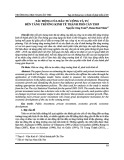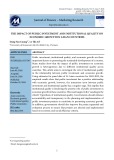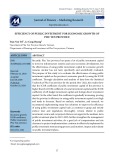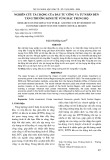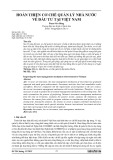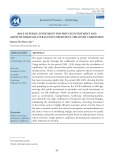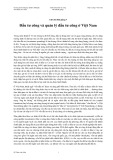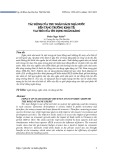
* Corresponding author
E-mail address: Farsat.ali@dpu.edu.krd (F. A. Shaban)
© 2020 by the authors; licensee Growing Science.
doi: 10.5267/j.uscm.2020.3.002
Uncertain Supply Chain Management 8 (2020) 537–546
Contents lists available at GrowingScience
Uncertain Supply Chain Management
home
p
a
g
e: www.Growin
g
Science.com/usc
m
The role of logistics service quality dimensions on marketing flexibility: An empirical study in
Dairy factories in Duhok governorate
Farsat Ali Shabana* and Dilgash Q. Mohamed Salihb
aTechnical College of Administration, Duhok Polytechnic University, Kurdistan Region, Iraq
bAmedi Technical Institute, Duhok Polytechnic University, Kurdistan Region, Iraq
C H R O N I C L E A B S T R A C T
Article history:
Received January 29, 2020
Received in revised format March
2, 2020
Accepted March 11 2020
Available online
March 11 2020
The aim of this study is to determine the role of logistics service quality (LSQ) in its functional
and operational dimensions on marketing flexibility in diary factories working in Duhok
governorate/Kurdistan region. The research problem arises through the research question
which states: Do logistics service quality dimensions contribute in achieving marketing
flexibility? The primary data used in this study was attained from a structured questionnaire
distributed to managers in examined factories. 34 valid questionnaires have been collected and
analyzed. The findings of the research show that there was a significant correlation and effect
between logistics service quality in its functional and operational dimensions on marketing
flexibility. The research presented a set of recommendations, the most important of which are:
focusing and attention to all dimensions of the (LSQ) in the researched factories, especially the
functional dimension of its greater contribution in achieving marketing flexibility.
.2020 b
y
the authors; license Growin
g
Science, Canada©
Keywords:
Logistics service quality
Marketing flexibility
Diary factories
1. Introduction
Change is an integral part of the nature and it is the only thing that has remained constant throughout
the evolutionary periods of humans, and this fact has become more evident in the present era, as change
controls all industrial and service sectors. This has got more intense because of globalization, rapid
technology developments, and work environment changes. This lead the modern organizations need to
depend on the new scientific methods in production, marketing and logistics fields in order to be able
to espouse with new and emerging challenges in different aspects. Many organizations tried to embrace
marketing flexibility to deal with all these changes and existential threats in the short and long term
(Shalender & Singh, 2015; Gilbert, 1999). On the other hand, some organizations concentrated on the
concept of logistics’ service quality dimensions after the results of many studies proved that the concept
directly affects the marketing mix. Many studies have confirmed the existence of a correlation and
effect of logistical activities on the marketing mix. Several other studies have also shown the role and
importance of logistics service quality in attaining different benefits for an organization, such as
competitive advantage and customer’s satisfaction and loyalty (Meidutė-Kavaliauskienė et al., 2014).

538
1.1. Research problem
Local industries in Iraq, including the Kurdistan Region have faced numerous problems and difficulties.
The most noticeable of these problems are the inability of the factories to market their products due to
weak government support and the adoption of an open market policy that filled the market with foreign
products that affected customers' orientation with a preference for foreign products (Al-Taei & Al-
Ameedi, 2018; Beraha et al., 2018; Goyal & Netessine, 2011). This status became clear to the researchers
more obviously through the field visits they made to dairy factories in Dohuk Governorate in order to get
to know their problems accurately. Hence, the following questions must be addressed,
1. Are the logistics service quality dimensions available in the researched factories?
2. Is marketing flexibility available in the research factories?
3. Do the logistics service quality dimensions contribute in achieving marketing flexibility in the
research factories?
1.2. Significance of the study
The current study derives its importance through its attempt to emphasis on the role that the logistics
service quality dimensions can play in attaining marketing flexibility, and this importance is
represented by the following:
1. Presenting a theoretical framework on the logistics service quality dimensions and marketing
flexibility concepts in the researched factories.
2. Warning the researched factories of the importance of the logistics service quality dimensions and
its contribution to achieving the marketing flexibility to face the foreign product and to market
their products efficiently.
1.4. Research objectives
In light of its problem and importance, the study seeks to achieve the following objectives:
1. Diagnosing logistics service quality dimensions and marketing flexibility dimensions in the
research factories and trying to evaluate their reality with regard to the current research interests
to determine means of development and upgrading it to enhance their position.
2. Testing the nature of the correlation and impact relationships between Diagnosing logistics
service quality dimensions and marketing flexibility in in the research factories.
1.5. Research model
The study will adopt the proposed research model (Fig. 1), which indicates the existence of correlation
and impact between logistics service quality dimensions as an independent variable (interpreter) and
marketing flexibility as a dependent variable (respondent).
1.6. Research hypotheses
H1: There is a significant correlation between logistics service quality dimensions and marketing
flexibility:
H1a: There is a significant correlation between functional logistics service quality dimensions and
marketing flexibility.
H1b: There is a significant correlation between operational logistics service quality dimensions and
marketing flexibility.

F. A. Shaban and D. Q. M. Salih /Uncertain Supply Chain Management
8 (2020)
539
H
2
: There is a significant impact of logistics service quality dimensions on marketing flexibility.
H
2a
: There is a significant impact of functional logistics service quality dimensions on marketing
flexibility.
H
2b
: There is a significant impact of operational logistics service quality dimensions on marketing
flexibility.
Fig. 1. The proposed study
1.7. Data collection method
The study was using survey method with distributed scales questionnaire to the studied factories in Duhok
governorate. The questionnaire included three parts. The first part concerns information of the
questionnaires’ respondents. The second part contains items related to independent variable (logistics
service quality dimensions). The total number for this part is 25 items: 15 items for functional logistics
service quality dimensions and 10 items for operational logistics service quality dimensions. Items for
measuring the independent variable (LSQ) dimensions were adopted from (Alemu, 2016; Tamang, 2014;
Mentzer et al., 2001; Chin et al., 2013; Jia et al., 2013). The third part of the questionnaire contains items
related to dependent variable (marketing flexibility) which contains 8 items and developed by Selcuk and
Gokpinar (2017) and Saura et al. (2008). All the identified items were measured using a 5-point Likert
scale.
2. Literature review
2.1. Logistics service quality
The beginnings of the logistic term back to the ancient Greek language, its source is the word (logos)
and its meaning is ratio or arithmetic (Rajan et al., 2005). Then in the late nineteenth century, the term
was used again in France by the army to express the transfer of materials, equipment and armies from
one place to another. The term was recently used in economics and business (Al-Ghamdi, 2017; Chen
& Qi, 2016). Law (2016) believes that logistics represents the operations to manage the strategies of
logistic activities and defines it as a process for managing the strategy of procurement, transportation
and storage of raw materials, spare parts and finished products within an organization and marketing
channels, so that current and future profitability is maximized, according to effective principles of cost
reduction. The definition of the service quality concept is the most used among authors and according
to them it is the degree to which the actual performance of the service matches the customer’s
Logistics’ service quality dimensions
Functional dimensions
Operational dimensions
Personnel contact
quality
Information
q
ualit
y
Handling wrong
orders
Order handling
quality
Marketing flexibility
Timeliness
Order quality
Order status
No. of orders Issued
Order accuracy

540
expectations for that service. Logistics service quality defined by Su and Sampaio (2012) as a measure
of the organization's ability to provide the product to customers at the specified time and place in the
required quantity and quality. While the American Logistics Workers' Board of Directors defined
logistics service quality as those works related to planning, implementing and controlling the efficient
and effective flow of raw materials, final goods and related information from the production place to
the consumption place in order to achieve the requirements of customer satisfaction (Lambert et al.,
2011). Roslan et al. (2015: 458) state that most definitions that are focused on the logistics service
quality see that achieving quality in the field of logistics services is possible if the customers'
requirements and expectations are matched with what they actually got from provided logistics service.
2.2. Logistics service quality dimensions
The (SERVQUAL) model presented by (Parasuraman et al., 1988) is one of the oldest models that pursue
to measure the service quality in general. This model has been applied and developed by numerous
authors. The idea of the model is based on the view that the customer's evaluation of the service quality
is crucial, and the service quality is evaluated by customers by identifying the gap between what they
expect from a service to the actual service performance. Ten dimensions were determined in the first form
of (SERVQUAL) model which were (reliability, responsiveness, efficiency, access, sympathy,
communication, credibility, security, customer understanding, and tangibility). In (1988) the author
merged and reduced the dimensions of (SERVQUAL) model to five dimensions (tangibility, reliability,
responsiveness, assurance, empathy) (Shaban et al., 2015). Cronin and Taylor (1992) proposed another
model of (SERVQUAL) with a different philosophy based on measuring the efficiency of service
performance rather than the gap, the two authors called their model (SERVPERF), and they demonstrated
the feasibility and accuracy of the new model to reach the results compared to the previous model (Alemu,
2016: 11). Then Mentzer et al. (2001) presented a modified model towards measuring the quality of
logistics service focusing on two main aspects: (Alemu, 2016, 12).
First: physical distribution service (Operational dimensions)
Second: Marketing customer service (Functional dimensions)
The model contains nine dimensions to measure the logistics service quality. The authors developed (25)
items to measure these dimensions. Two or three items are used to measure each dimension. Kamble et
al. (2011: 82) indicate that the model of Mentzers et al. (2001) added the functional quality side of the
logistics service with the technical operational side, and the technical quality indicates the results of the
service, while the functional quality indicates the service delivery process. Based on the above, the
researchers will adopt Mentzer et al. (2001) model to assess the quality of the logistic service with its nine
dimensions divided into two main dimensions as shown in Table 1.
Table 1
Definitions of logistics service quality dimensions
Source: Alemu , Hana, 2016, Implication of logistics service quality on customer satisfaction: the case of Jumia online market , a thesis, Addis Ababa
University School of Commerce .
Definitions Dimensions
Functional
dimensions
Indicates the customer's perceptions about the communication process by
organization staff.
Personnel contact quality
Indicates the efficiency and effectiveness of the procedures followed by the
organization
Order procedure
Indicates how the organization handles wrong orders on arrival. Order discrepancy handling
Refers to the customer's perceptions of the information provided by the
organization regarding the products that the customer may choose
Information quality
Operational
dimensions
Indicates the availability of the required product and the quantities utilized from it. Order release quantities
Refers to the extent to which orders are matched to customer requests upon arrival Order accuracy
Indicates that there is no dama
g
e to orders Order Conditio
n
It indicates the product’s quality, and this includes the extent to which it meets the
re
q
uired
p
roduct s
p
ecifications and customer needs.
Order quality
Refers to or
g
anization's abilit
y
to deliver orders to the customer's
p
lace on time. Timeliness

F. A. Shaban and D. Q. M. Salih /Uncertain Supply Chain Management 8 (2020)
541
2.3. Marketing flexibility
Several studies have addressed flexibility concept, but there are a few of studies dealing with marketing
flexibility (Shalender & Sushil, 2017). During the past 30 years, flexibility concept has mostly been
linked with production processes, strategy and human resource management, but very few studies have
linked flexibility with marketing (Combe, 2012). The flexibility concept, according to many authors,
refers to adaptation and response to environmental change, ensuring that organizations survive and
grow (Li et al., 2010). Marketing flexibility is one of the various forms of flexibility that organizations
use as a strategy to maintain their competitive advantage (Singh & Shalender, 2015). The need for
marketing flexibility emerged as a result of the competitive landscape of postmodern marketing, and
due to recent developments, the concept has become a priority in the forefront of marketing issues, and
its idea and actions are centered on customers by enhancing the value to them through participation,
interaction and implementation. According to Grewal and Tansuhaj (2001) marketing flexibility is one
of the strategies that many organizations use to counter changes by resetting their marketing efforts.
Shalender and Sushil (2015) confirm the previous opinion by linking marketing flexibility with
organization's capabilities and mentioned that it is a concept that indicates the organization's ability to
enter or exit markets, and its position in existing and new markets.
3. Data analysis
3.1. Variables Description and testing hypotheses
The content of this part includes the statistical description (mean, standard deviation, and response rate)
of the research variables as perceived by the study sample in the researched factories based on the
Likert scale, and to achieve this the researchers used SPSS program as follow:
3.1.1. Statistical description of the variables of logistics service quality dimensions
Table 2
Statistical description of the variables of logistics service quality dimensions
N. Variables Items Mean Stander
deviation
Response
rate Arrangement
X1 Personnel
contact
quality
Our factor
y
members make a
g
reat effort to understand customer needs. 4.47 0.74 89.4 3
X2 Problems are easily handled by our factory employees. 4.53 0.66 90.6 1
X3 Individuals with the necessary expertise and skill work in our factor 4.29 0.83 85.8 6
X4 Order
procedure
Our factory procedures are easy when placing an order for products. 4.50 0.74 90 2
X5 Our factory applies the conditions agreed upon in its procedures when
ordering products. 4.41 0.70 88.2 4
X6 Order
discrepancy
handling
Our factor
y
allows the replacement of non-conformin
g
products. 4.32 0.97 86.4 5
X7 Our factory deals well with the wrong products. 3.50 1.50 70 8
X8 Our factory compensates its customers for errors in their order. 4.50 0.74 90 2
X9 Information
quality
Our factory gives customers the necessary information about the
p
roducts. 4.24 0.78 84.8 7
X10 Our factory provides accurate information about the delivery times of the
p
roducts. 4.32 0.84 86.4 5
Average
4.3 0.85 86.16
The results of Table 2 illustrate that the answers of the respondents about the variables of functional
dimension through its items (X1-X10) is consistent in terms of the general mean that reached (4.3),
which is greater than the proposed mean (3) on the Likert-scale used in the study. The value of general
standard deviation was (0.85), and the average response rate (86.16%), which indicates that the
response rate is high for the respondents' answers to the functional dimension items. Among the most
prominent variables that contributed to enriching the variable agreement ratio (X2), as it obtained the
highest mean (4.53) and a response rate of (90.6%). This indicates that the studied factories were able
to easily address all of its customers' problems.

